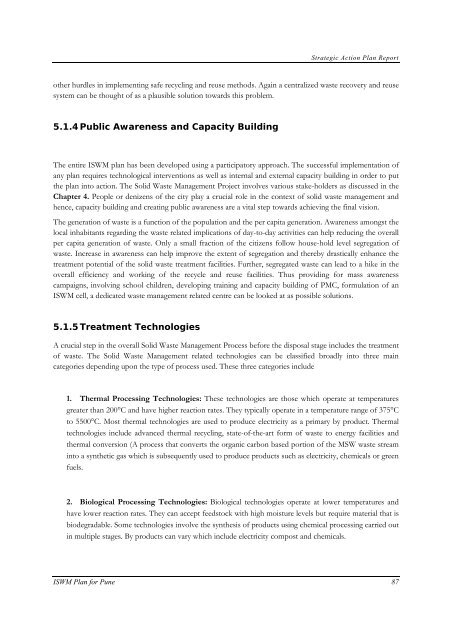Strategic Action Plan - International Environmental Technology Centre
Strategic Action Plan - International Environmental Technology Centre
Strategic Action Plan - International Environmental Technology Centre
Create successful ePaper yourself
Turn your PDF publications into a flip-book with our unique Google optimized e-Paper software.
<strong>Strategic</strong> <strong>Action</strong> <strong>Plan</strong> Report<br />
other hurdles in implementing safe recycling and reuse methods. Again a centralized waste recovery and reuse<br />
system can be thought of as a plausible solution towards this problem.<br />
5.1.4 Public Awareness and Capacity Building<br />
The entire ISWM plan has been developed using a participatory approach. The successful implementation of<br />
any plan requires technological interventions as well as internal and external capacity building in order to put<br />
the plan into action. The Solid Waste Management Project involves various stake-holders as discussed in the<br />
Chapter 4. People or denizens of the city play a crucial role in the context of solid waste management and<br />
hence, capacity building and creating public awareness are a vital step towards achieving the final vision.<br />
The generation of waste is a function of the population and the per capita generation. Awareness amongst the<br />
local inhabitants regarding the waste related implications of day-to-day activities can help reducing the overall<br />
per capita generation of waste. Only a small fraction of the citizens follow house-hold level segregation of<br />
waste. Increase in awareness can help improve the extent of segregation and thereby drastically enhance the<br />
treatment potential of the solid waste treatment facilities. Further, segregated waste can lead to a hike in the<br />
overall efficiency and working of the recycle and reuse facilities. Thus providing for mass awareness<br />
campaigns, involving school children, developing training and capacity building of PMC, formulation of an<br />
ISWM cell, a dedicated waste management related centre can be looked at as possible solutions.<br />
5.1.5 Treatment Technologies<br />
A crucial step in the overall Solid Waste Management Process before the disposal stage includes the treatment<br />
of waste. The Solid Waste Management related technologies can be classified broadly into three main<br />
categories depending upon the type of process used. These three categories include<br />
1. Thermal Processing Technologies: These technologies are those which operate at temperatures<br />
greater than 200°C and have higher reaction rates. They typically operate in a temperature range of 375°C<br />
to 5500°C. Most thermal technologies are used to produce electricity as a primary by product. Thermal<br />
technologies include advanced thermal recycling, state-of-the-art form of waste to energy facilities and<br />
thermal conversion (A process that converts the organic carbon based portion of the MSW waste stream<br />
into a synthetic gas which is subsequently used to produce products such as electricity, chemicals or green<br />
fuels.<br />
2. Biological Processing Technologies: Biological technologies operate at lower temperatures and<br />
have lower reaction rates. They can accept feedstock with high moisture levels but require material that is<br />
biodegradable. Some technologies involve the synthesis of products using chemical processing carried out<br />
in multiple stages. By products can vary which include electricity compost and chemicals.<br />
ISWM <strong>Plan</strong> for Pune 87
















